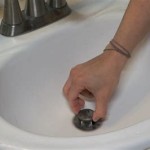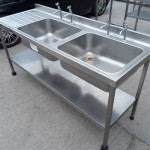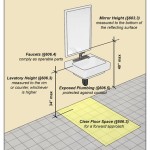Tiny Bugs By Kitchen Sink
If you've noticed tiny bugs around your kitchen sink, you're definitely not alone. These miniscule creatures are quite common, and while they're generally harmless, they still are a nuisance that no one wants to deal with. The good news is that there are a few simple methods you can use to get rid of them for good.
The first step is to identify the type of bug you're dealing with. Fortunately, this is often easy to do, as each bug has its own unique characteristics. Here are a few of the most common types of tiny bugs that are found around kitchen sinks:
- Fruit Flies: These tiny bugs are attracted to ripe fruit, but they can also be found around sinks that are not properly cleaned. They lay their eggs in moist areas, so it's important to keep your sink clean and dry to prevent an infestation.
- Drain Flies: Drain flies are attracted to the organic matter that builds up in drains. They lay their eggs in the moist, slimy film that forms on the sides of drains, so it's important to clean your drains regularly to prevent an infestation.
- Springtails: Springtails are tiny, wingless insects that are attracted to moisture. They can be found in damp areas, such as around sinks and in basements. They don't bite or sting, but they can be a nuisance.
- Sowbugs: Sowbugs are small, gray bugs that roll up into a ball when they're disturbed. They're attracted to moist areas, and they can be found around sinks and in basements. They don't bite or sting, but they can be a nuisance.
Once you've identified the type of bug you're dealing with, you can start to take steps to get rid of them. Here are a few tips:
- Keep your sink clean: This is the most important step you can take to prevent bugs from congregating around your sink. Rinse out your sink regularly so that food particles do not build up and attract bugs. Wipe down the counter and back-splash with a disinfectant to remove any spills or residue.
- Clean your drains: Drains are a breeding ground for bugs, as organic matter builds up and creates a suitable environment for them to lay their eggs. To clean your drains, pour a solution of baking soda and vinegar down the drain in the evening, and then flush the drain with hot water in the morning.
- Use a bug spray: If you're dealing with a severe infestation, you may need to use a bug spray. There are a variety of bug sprays available, so choose one that is specifically designed for the type of bug you're dealing with.
- Call a pest control company: If you're unable to get rid of the bugs on your own, you can call a pest control company. They will be able to identify the type of bug you're dealing with and recommend the best course of treatment.
By following these tips, you can get rid of tiny bugs around your kitchen sink quickly and effectively. These bugs are typically harmless, but they can still be a nuisance that no one wants to deal with, so it's best to nip the problem in the bud as soon as possible.

Species Identification What Are These Bugs Skittering About The Kitchen Sink Biology Stack Exchange

Species Identification What Are These Bugs Skittering About The Kitchen Sink Biology Stack Exchange

Species Identification What Are These Bugs Skittering About The Kitchen Sink Biology Stack Exchange

Tiny Bugs In Kitchen

Bugs In Kitchen Sink Hometalk

14 Types Of Kitchen Bugs With Pictures Identification Guide

7 Tiny Black Bugs In Kitchen Sinks

Species Identification What Are These Bugs Skittering About The Kitchen Sink Biology Stack Exchange
Why Are These Popping Up Under My Kitchen Sink And How Do I Get Rid Of Them Diy Home Improvement Forum

Why Do I Keep Seeing Very Tiny Ants Around My Kitchen Sink







